This is a Minolta Hi-Matic E 35mm rangefinder camera made by Minolta Camera Co. starting in 1971. It was one of the last quality Minolta rangefinder cameras with fast sub f/2 lenses before the line was replaced with cheap point and shoot models that were manufactured by third party companies. The Hi-Matic E has full programmed auto exposure and no manual control meaning it was likely dismissed by serious photographers and as such has remained an under the radar model, even today.
Film Type: 135 (35mm)
Lens: 40mm f/1.7 Minolta Rokkor-QF coated 6-elements
Focus: 2.6 feet to Infinity
Viewfinder: Coupled Rangefinder with Projected Brightlines and Parallax Correction
Shutter: Seiko-ESF Leaf
Speeds: B, 2 – 1/1000 seconds
Exposure Meter: Coupled CdS Cell with Programmed Auto Exposure
Battery: 2x PX640 1.35v Mercury Cells
Flash Mount: Hotshoe and X Flash Sync
Weight: 567 grams
Manual: http://www.cameramanuals.org/minolta_pdf/minolta_hi-matic_e.pdf
My Thoughts
A question that often gets asked of film enthusiasts and collectors is “what is the best (or perfect) camera”. This is a loaded question as what’s best for one person might not be for another. People have varying needs and preferences that would cause them to rank one model higher than another. Sometimes there is no “best” of anything. I explored this concept recently in my review of the Kodak Retina Ib where I declare it my favorite Retina, even though it was a lower end Retina, and has a few annoyances that I don’t like.
Given the understanding that there isn’t a perfect or best of any kind of camera, we should look at characteristics of models that are generally more desirable by people.
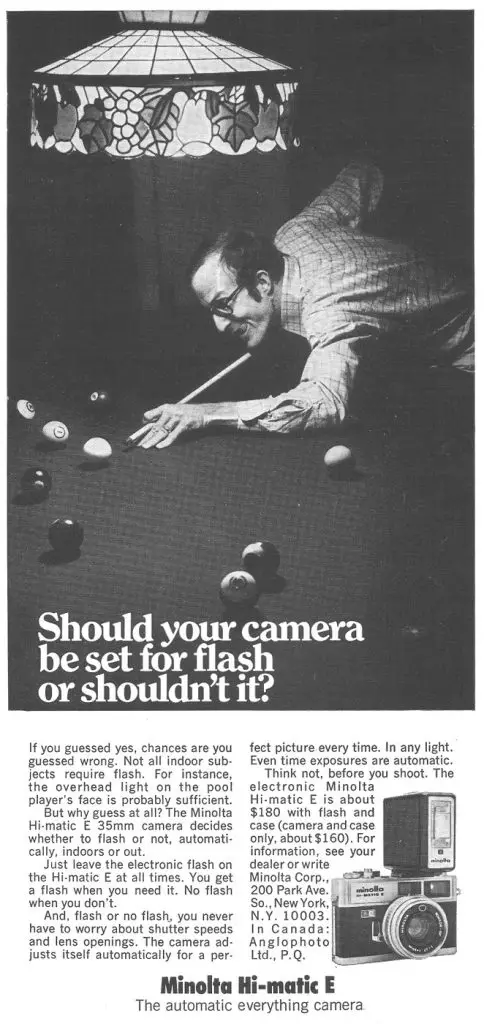
- Lens – Cameras are first and foremost tools that are supposed to make images. In order to make a good image, you need a good lens, so having a sharp and fast lens is usually high on people’s wish lists for a “best” camera.
- Shutter – The shutter is second only to the lens in terms of what is needed to make good photographs. A highly precise shutter that reliably fires at the speed it’s supposed to, and with a wide range of available speeds is almost always a requirement of a good camera.
- Good Viewfinder – It is really difficult (although not impossible) to make a good photograph if you can’t see what you’re about to photograph, so a large and bright viewfinder is often high up on people’s wishlists for a camera. If you’re talking about an SLR, you want a bright and easy to use view screen with at least one or two focus aides to help get accurate focus. In the case of a rangefinder, the focus patch should be large and bright with enough contrast to accurately get good focus, even in low light.
- Size and Ergonomics – The shape, size, and layout of the controls of a camera is a highly subjective one as some people have larger hands than others and have a specific tolerance for what works best for them. But I don’t think I’ve ever heard of someone ever say “I want a camera that’s unnecessarily big”. So I think it’s safe to conclude that for a camera to be the ‘best’ it should strike some balance of size in which there’s no unnecessary weight, while not being so small that the essential controls are put in awkward locations.
- Automation – This one’s probably the most subjective here as automation is both a blessing and a curse at the same time. Some people prefer all manual mechanical cameras as they tend to be more reliable since there’s nothing to go wrong. On the other hand, a good meter with an accurate exposure system is quite valuable too, allowing the camera to be used by novices, and in more diverse lighting situations.
- Looks – Again, another subjective one, but if you were to compare two otherwise identical models, but one was prettier than another, I think it’s fair to say the good looking one will generally get picked up more often. There is a reason that companies like Fuji and Olympus currently make modern digital cameras with design elements that hearken back to the classic days. People have huge collections of Leicas, Exaktas, and Rolleis not just because they’re great cameras, but they are extremely good looking cameras. So yeah, all things being equal, a good looking camera will never hurt it’s chances at being recommended by someone.
I could probably go on into more nit picky characteristics like battery selection, brand recognition, focus throw, and other bells and whistles that some cameras have, but I think the above 6 criteria are what most people think of when making a recommendation for a “best” camera.
This Minolta Hi-Matic E checks the boxes of almost everything above. Introduced in 1971 as an introduction to fully automatic programmed auto exposure rangefinders, it had a glorious 6-element Rokkor lens with a slightly wide 40mm focal length allowing for more depth of field, and easier composition in tight spaces. The camera was available in both chrome and black versions, although black Hi-Matic E’s are quite rare. The ad above from a 1972 issue of Popular Mechanics suggests a retail price of $160 for the camera and case which when adjusted for inflation is about $950 today.
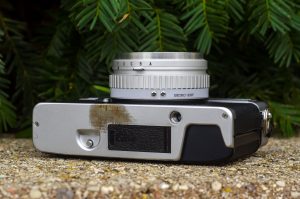
The Seiko shutter is a very high quality design with an unusually wide range of shutter speeds from 2 seconds all the way up to 1/1000th of a second. This significantly beats the Canonet GIII QL17 rangefinder which is one of the most highly recommended 1970s rangefinders with it’s range of 1/4 to 1/500. It is rare to find any leaf shutter camera that can stay open longer than 1 second or hit the magical 1/1000 speed, yet this one can do both.
The benchmark for what a great rangefinder viewfinder should be is the Leica M3, and while the Hi-Matic E is not in that league, it is still very good. The viewfinders of every Minolta rangefinder I’ve used has consistently had very good brightness and contrasty focus patches, even the Minolta A from 1955. The bluish tint to the main part of the viewfinder improves contrast in the large and bright viewfinder. It may not be the best ever made, but there are many very capable cameras that had far worse viewfinders than this.
The size and layout of the controls of the Hi-Matic E is in that “perfect balance” that became common in the 1970s. While SLRs were already reigning supreme by the time this model was introduced, there was still a market for a high quality but compact camera. The Hi-Matic is much smaller than earlier rangefinders like the original Minolta Hi-Matics or the Yashica Electro, but not so small as to compromise the layout of the controls like many point and shoot cameras did. I found the controls on the Hi-Matic E to be nearly perfect with only two nitpicks. The first being that the shutter release has an abnormally long travel before the shutter actually fires, and the second being the very short focus throw of the lens. The long shutter release travel was likely due to the metering system and the short focus throw was par for the course of a 70s rangefinder as every competing model had a very short focus throw. This was likely done as a necessity to keep the size of the camera down.
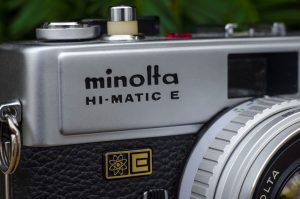
While the automation part was actually the main selling point of the Hi-Matic E, offering a reliable CdS meter and full Program Auto Exposure, it comes at the expense of any sort of manual control. It seems that by the 1970s, the major companies saw the need for manual control to be outside of the target audience these cameras were marketed towards. The good news is that the exposure system in the Hi-Matic E is very good, offering a range from 0.5 EV to 17 at f/1.7 using 100 speed film. This was a much wider range than many other SLRs and rangefinders of the day. The metering system was designed by Yashica and licensed to Minolta using the “Electro” name. You’ll notice the same type of atom logo on the front of the camera as is found on the Yashica Electro. The top plate of the camera has a red light indicating “Electro Control”. Despite the impressive metering abilities of the camera, many collectors turn their noses away from fully automatic cameras with no manual override.
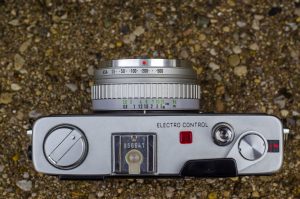
Finally, the looks. Any time you have a large front element from a fast f/1.7 lens like the one found here, you’re already off to a good start. The Minolta Hi-Matic E is far from a spartan camera, but it’s design is on the conservative side, and I find that to be a good thing. The focus ring has a deeply knurled pattern that improves grip, the body covering has a nice texture with good grip that allows the camera to be held one handed with confidence that it won’t slip out of your hands. The motions of the focus ring and wind lever are met with just the right amount of resistance to still remain fluid, without feeling cheap. Although there is quite a bit of plastic on the camera, it is clear the Minolta Hi-Matic E was designed with quality in mind as nothing about it feels cheap or “entry level”. Even after well over 40 years, all of the tolerances on the camera are tight and with no play suggesting Minolta took no shortcuts in the assembly of this camera.
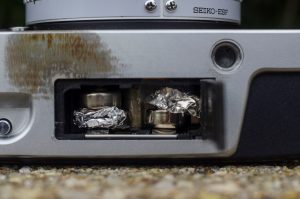
In the world of “cons”, the biggest one here is the availability of batteries. The Hi-Matic E was designed to use two PX640 mercury batteries which are no longer made. There are many types of mercury batteries that have a modern alkaline, lithium, or silver oxide equivalent, but not the PX640. In order to power the camera, you need to find a battery and either buy or make an adapter. There are several sellers on eBay that offer machined LR44 to PX640 adapters, or you can do what I did, and roll up a small wad of aluminum foil and wedge it in between the battery and the terminal. It is very important that you don’t allow your foil to overlap to the other battery compartment creating a short. So just be sure that when you stick it in there, its in there snugly.
As rudimentary as this seems, it worked well. The voltage difference between modern 1.5v batteries and the original 1.35v mercury batteries this camera was designed for should not negatively impact the meter. I will say that alkaline batteries are known for having a gradual decrease in voltage as they age, so that could cause problems with the camera’s meter if you don’t always have fresh batteries in the camera, so I would recommend finding a lithium or silver oxide equivalent just to be safe.
I picked this camera up in a lot of other cameras, and knowing it’s reputation for being fully dependent on it’s meter and seeing a strange stain on the bottom plate of the camera near the battery compartment, I was less than thrilled with the prospect of using it.
It wasn’t until I held the camera that I became impressed with it’s size, heft, and layout. The Minolta Hi-Matic E is a joy to hold and even without batteries, peering through the viewfinder suggested that this was quite a capable little camera. Since this is an entirely electronic camera, you cannot test the shutter without power. You can wind the camera one time, but it will not fire, not even at a single speed. I was elated that all it needed was fresh batteries and the camera fired right up.
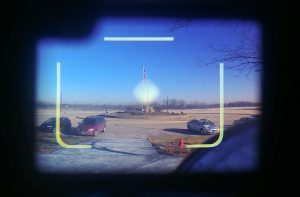
In addition to being large and bright with a very contrasty rangefinder patch, the viewfinder also has 40mm projected frame lines with automatic parallax correction. In the upper left corner is a little light that shows green to confirm the battery power is sufficient before firing the shutter, but if it turns red, that means that a shutter speed lower than 1/30 is going to be used and that camera stabilization is recommended.

The Hi-Matic E also has a dedicated flash mode which can signal a little lighting bulb light in the upper right corner of the viewfinder when using flash, but this wasn’t something I experimented with as I almost never use flash in my reviews.
The back of the camera has an Auto / Manual switch which allows you to manually fire the flash even if the camera’s meter doesn’t think you need it. This is useful if you are shooting in bright sunlight and want to use the flash as a fill flash to eliminate shadows, or if you just feel like you need extra light for artistic effect. Next to the Auto / Manual switch is a film travel indicator that will jiggle when the film is correctly traveling inside of the camera.
In my research for this model, I found a variant of the Hi-Matic E called the Hi-Matic ES that was sold exclusively through K-Mart stores. Mike Butkus has manuals for both. At first, the two models seemed to be identical, and I wondered if perhaps one was a market variant sold in a different country, much like how Nikkormats and Nikomats are the same exact camera, just sold in different markets, but then I saw that the ES was an economy model lacking a self timer or the ability to manually control the flash mode of the camera.
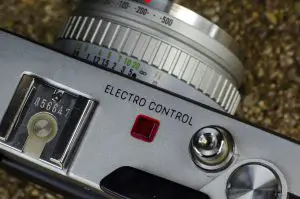
There would also be a Hi-Matic F which had a simpler 4-element f/2.7 lens, but would still retain the Electro exposure system. The Hi-Matic E would be in production for at least three years, eventually being replaced by the Hi-Matic G which continued the trend of simplification. As the years wore on, rangefinders would continue to lose features, eventually becoming entry level economy cameras.
What at first I thought was going to be another hum-drum 1970s rangefinder with limited control, turned out to be an exceptional experience. I thoroughly enjoyed my first use of the camera. There wasn’t a single thing about the shooting experience that I didn’t like, and I never once missed the lack of manual control. Despite being nearly 46 years old, I trusted the Electro Control system to handle everything. Would I regret this decision?
My Results
My first roll of film in the Hi-Matic E was my color standby, Fuji 200. I took it in mid October to a local family farm to pick some pumpkins and relied entirely on the meter to get the exposure correct. It was a bright and clear day, so a majority of my images were in bright sunlight, but I also made it a point to shoot it in shade and indoors to see how it would respond to a variety of lighting conditions.
Images from the Hi-Matic E, came out spectacular. The 6-element Rokkor lens rendered colors nicely and with sharpness that is even across the whole frame. Brightness was even with no vignetting in any of the images. On several of the outdoor images, the exposures favored a bit towards overexposure which could be a result of me using a higher voltage silver oxide battery in lieu of the 1.35v mercury batteries this camera was designed for. Then again, the exposure system on this camera was borrowed from the Yashica Electro and I have a great deal of experience with those cameras and have never noticed an overexposure problem using similar silver oxide batteries. The camera does not offer any direct +/- EV control, so the next time I take this camera out, I will intentionally set the shutter speed one stop faster than I’m really using and see if I get more accurate exposures.
Beyond my observations of the exposure, the Hi-Matic E delivered exactly the experience I had hoped for. The camera is small and compact, has excellent ergonomics, a large and bright viewfinder and easy to use rangefinder, an exposure system that likely when used with the correct batteries was spot on, and a glorious and fast Rokkor lens. Reading some of the other reviews online of this very camera, I found one consistency between them all. While not everyone appreciated the size, throw of the shutter release, or the lack of manual control as I did, each reviewer heaped unanimous praise over the lens, calling it one of the sharpest 35mm lenses out there, to which I absolutely agree!
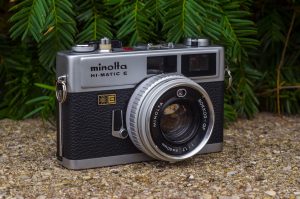 The price of this camera when it was new was $160 which when adjusted for inflation is just under a thousand dollars today, putting it in the “pro-sumer” segment. If I’m going to spend nearly a thousand dollars on a camera, it better deliver some mighty excellent images. I’d say that it does that well, but as a pro-sumer photographer in 1972 when this camera first went on sale, would I have demanded more control over my camera? Probably. I don’t know exactly how long this camera was in production or how many were made, but I am going to guess it only saw moderate success.
The price of this camera when it was new was $160 which when adjusted for inflation is just under a thousand dollars today, putting it in the “pro-sumer” segment. If I’m going to spend nearly a thousand dollars on a camera, it better deliver some mighty excellent images. I’d say that it does that well, but as a pro-sumer photographer in 1972 when this camera first went on sale, would I have demanded more control over my camera? Probably. I don’t know exactly how long this camera was in production or how many were made, but I am going to guess it only saw moderate success.
None of that matters today of course as these cameras can often be picked up for very little money. Adapting the battery compartment to accept modern batteries merely requires a bit of foil, and assuming the metering circuit is working, you have yourself a really nice and compact camera that’s going to give you some really excellent photographs. Manual controls or no manual controls, this is a winner in my book! If you happen to come across a Minolta Hi-Matic E in working condition, I think you’ll declare it a winner as well.
My Fnal WordHow these ratings work |
The Minolta Hi-Matic E was a fully automatic rangefinder with an excellent lens, excellent viewfinder, and excellent meter. It is a handsome and compact camera that easily fits in a large coat pocket or small handbag, making for an extremely capable daily camera. The biggest con most people say about this camera is that it lacks any sort of manual control, but with the excellent meter, you won’t ever miss it. Thankfully these cameras have very little value today meaning they can be picked up for next to nothing. Although the batteries that this camera was made for have no modern replacements, a standard button cell battery and some tin foil is all you need to get them working again. If you find one for cheap, I highly recommend giving one a try. | ||||||
| Images | Handling | Features | Viewfinder | Feel & Beauty | History | Age | |
| 2 | 2 | 1 | 2 | 1 | 0 | 20% | |
| Bonus | none | ||||||
| Final Score | 9.6 | ||||||
Additional Resources
https://en.wikipedia.org/wiki/Minolta_Hi-Matic
http://mattsclassiccameras.com/rangefinders-compacts/minolta-himatic-e/
https://www.lomography.com/magazine/17244-minolta-hi-matic-e
https://filmphotographyproject.com/content/reviews/2012/09/minolta-hi-matic-e-camera/
https://www.35mmc.com/19/04/2014/minolta-hi-matic-e-rangefinder/
https://www.photo.net/discuss/threads/first-roll-from-minolta-hi-matic-e.442265/

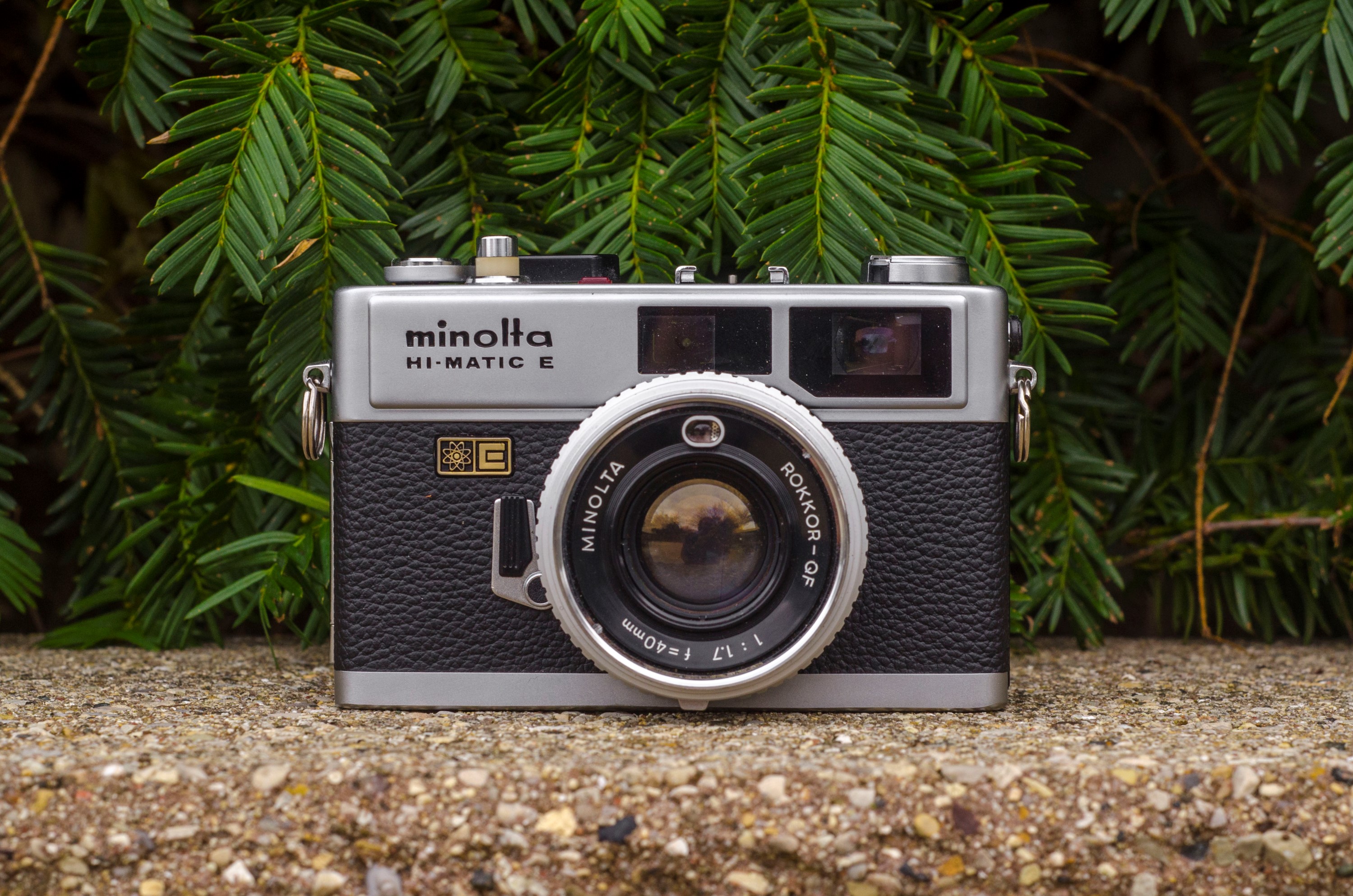

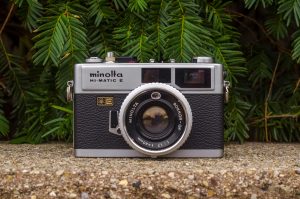










I second the opinion that this is an excellent camera. In 1977 I started Optometry School and by the 2nd year two of us decided we should have a yearbook which was very rarely done. By that time I had an SRT-101, SRT-202 and an XG-M. However, when it came to shooting candid on the move shots of students in class and clinic I used my father’s Hi-Matic E. He never used it but I found that combined with the Minolta flash this was the perfect camera for the task. Can’t say enough positives about this Minolta and I still have it today.
You can’t set the shutter speed, set the film sensitivity instead on the front ring. It gives you exposure compensation in +/-0.3 EV steps.
That sounds really difficult, and I wonder if it’s necessary. There are a range of simple lenses with “character” being made these days by Chinese manufacturers – they might be a much simpler way and less expensive to get the effect you’re looking for. Think about something like the 7artisans Photoelectric 35mm f/1.2, the TTArtisan 35mm f/1.4, or other lenses by Laowa or Viltrox.
I too have a Hi Matic E. Bought probably 4 years ago for under £20 via eBay.
After reading your review, it’s on my list to use with the next role of film. I usually alternate 4 or 5 film cameras, 3 of which are rangefinders. I must add the E to the list and get using it.
Happy to report that it all appears to work. Just a roll of 2013 Agfa APX and a London excursion to let it perform.
Thank you for writing your reviews. Most enjoyable.
Best regards,
Andy.
Andy, I am happy I inspired you to use this wonderful camera. There are other compact 35mm rangefinders from this era that have a similar feature set (the Yashica Electro GX comes to mind), but I REALLY liked the Hi-Matic E and look forward to taking it out again soon!
Just got mine last March 17! I’m excited to use it!
Hi! I recently got my Minolta Hi-Matic E and I was wondering, how long do your batteries last?
I wish I would give you a better answer, but as I’ve only shot mine twice, I cannot say how long the batteries last. I would imagine that they should last about as long as most batteries of the type, which is about a year with average use.
I converted mine to use a Eveready 2L76 battery. I installed a Schottky diode to break the voltage down to 1.3 volts. Now there is no problem when shooting overexposed photos. A great camera without the worry of performing manual adjustment if your in a hurry to shoot
Hi – Is there a way to harvest the lens out of it and adjust the aperture somehow (it lacks the aperture ring)? I am thinking about using it converted and mounted on my Nikon z30.
Wish I could help you but I don’t know. Removing lenses from fixed lens cameras is possible, but requires total disassembly of the camera, removing tje shutter blades or finding a way to keep them permanently open, and then fabricating some kind of adapter to whatever system you want to use it on. Something I have no experience with. Good luck!